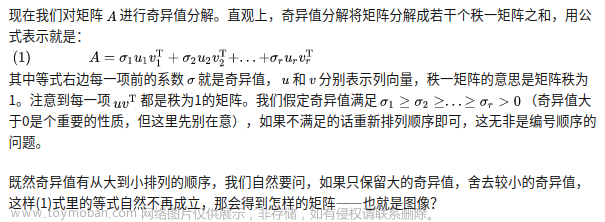非奇异矩阵求逆
import torch
x = torch.FloatTensor([[[1.0, 2.0],
[1.0, 4.0]],
[[1.0, 2.0],
[1.0, 3.0]]])
y=torch.inverse(x)
print(y)
输出结果为
tensor([[[ 2.0000, -1.0000],
[-0.5000, 0.5000]],
[[ 3.0000, -2.0000],
[-1.0000, 1.0000]]])
或者用
y=torch.linalg.inv(x)
也可以得到相同的结果
奇异矩阵求逆
import torch
x = torch.FloatTensor([[[1.0, 2.0],
[1.0, 2.0]],
[[1.0, 2.0],
[1.0, 3.0]]])
y=torch.inverse(x)
print(y)
报错:
RuntimeError: inverse_cpu: The diagonal element 2 is zero, the inversion could not be completed because the input matrix is singular.
法1:计算矩阵行列式,计算abs(det)>0的矩阵的逆,删除奇异矩阵。缺点是改变了张量维度。
import torch
from torch.linalg import det
x = torch.FloatTensor([[[1.0, 2.0],
[1.0, 2.0]],
[[1.0, 2.0],
[1.0, 3.0]]])
determinants = torch.det(x)
y =torch.inverse(x[determinants.abs()>0.])
print(y)
输出结果为
tensor([[[ 3., -2.],
[-1., 1.]]])
法2:用torch.linalg.pinv()得到奇异矩阵的伪逆矩阵
import torch
x = torch.FloatTensor([[[1.0, 2.0],
[1.0, 2.0]],
[[1.0, 2.0],
[1.0, 3.0]]])
y=torch.linalg.pinv(x)
print(y)
输出结果为文章来源:https://www.toymoban.com/news/detail-527118.html
tensor([[[ 0.1000, 0.1000],
[ 0.2000, 0.2000]],
[[ 3.0000, -2.0000],
[-1.0000, 1.0000]]])
自定义求逆函数,仅针对非奇异矩阵
import torch
import numpy as np
from torch.linalg import det
def cof1(M,index):
zs = M[:index[0]-1,:index[1]-1]
ys = M[:index[0]-1,index[1]:]
zx = M[index[0]:,:index[1]-1]
yx = M[index[0]:,index[1]:]
s = torch.cat((zs,ys),axis=1)
x = torch.cat((zx,yx),axis=1)
return det(torch.cat((s,x),axis=0))
def alcof(M,index):
return pow(-1,index[0]+index[1])*cof1(M,index)
def adj(M):
result = torch.zeros((M.shape[0],M.shape[1]))
for i in range(1,M.shape[0]+1):
for j in range(1,M.shape[1]+1):
result[j-1][i-1] = alcof(M,[i,j])
return result
def invmat(M):
return 1.0/det(M)*adj(M)
x = torch.FloatTensor([[1.0, 2.0],
[1.0, 4.0]])
print(invmat(x))
输出结果:文章来源地址https://www.toymoban.com/news/detail-527118.html
tensor([[ 2.0000, -1.0000],
[-0.5000, 0.5000]])
到了这里,关于pytorch对矩阵(奇异和非奇异)求逆的文章就介绍完了。如果您还想了解更多内容,请在右上角搜索TOY模板网以前的文章或继续浏览下面的相关文章,希望大家以后多多支持TOY模板网!










